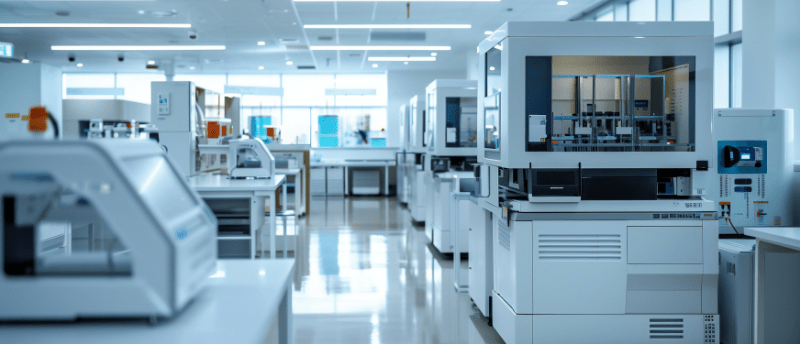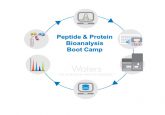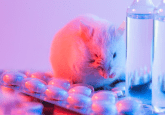Small molecule method development strategies with Chad Christianson

In bioanalytical method development, efficiency and quality must coexist despite their competing demands. In this interview, Chad Christianson shares his insights on maximizing laboratory resources without compromising scientific integrity and describes how he and his team determine methods to be “good enough” for study initiation. Chad navigates the advantages and limitations of different mass spectrometry platforms — triple quadrupole vs HRMS — and reveals his pragmatic approach to method development.
 Chad Christianson
Chad Christianson
Analytical Development Manager
Alturas Analytics, Inc. (ID, USA)
Chad has over 24 years of related experience as an Analytical Scientist, with 20 years focused on bioanalysis at Alturas Analytics. This depth of experience in applied LC–MS/MS, LC-HRMS and GC–MS/MS, along with an education in chemical engineering, provides the backbone for productive and innovative science.
As Analytical Development Manager, Chad is responsible for the supervision of the analytical method development team, supporting complex method development, new technology evaluation/implementation and providing technical oversight to clients across all therapeutic areas. His additional responsibilities include acting as Study Director/Principal Investigator on GLP and clinical Studies. Chad also provides oversight of the research program, including supervising the development of the internship/outreach/graduate programs as well as overall production of Alturas publications and scientific outreach.
- What approaches have you found most effective for maximizing resources during method development without compromising quality?
- Can you share some strategies you’ve used in your own team?
- One of the challenges in method development is knowing when a method is ‘good enough’ to move forward to study initiation. How do you determine when a method is ready to progress?
- What are the advantages and disadvantages of using a triple quadrupole mass spectrometer and HRMS systems when developing methods?
- When advising clients or colleagues on whether to opt for a triple quad system or a quadrupole time-of-flight or Orbitrap system, what factors typically drive that decision?
- Can you share some specific examples of where one outshines the other?
- How long does it take to develop a method for a single analyte for non-GLP discovery use, assuming a well-behaved molecule?
What approaches have you found most effective for maximizing resources during method development without compromising quality?
Start simple. Always begin with a standard column, mobile phases and extraction. Utilize platforms that are in less demand to determine extraction efficiency and the LC–MS/MS parameters. Be selective with the personnel who are conducting the method development. The developer must have adequate training and experience to ensure a successful method.
The expectations of the method should be clearly outlined prior to beginning the development: required retention, recovery, accuracy, etc. Make sure that the developer has vital analyte information to be successful in a timely manner. At a minimum, the developer needs to know the purity of the neat compound, solubility properties and past data for similar compounds.
The analyte structure is also very helpful for determining the analyte’s lipophilicity, which then speeds up the LC development; however, some clients are hesitant to supply this information. The developer also needs to be flexible to fit the method development in between sample analysis batches in order to maximize the profits of the lab. Management has the burden of balancing sample analysis with method development resource requirements to be profitable but get the next method ready to analyze the new samples.
Can you share some strategies you’ve used in your own team?
We begin with tuning on any instrument available, but if possible, use the platform that will be used for sample analysis. Since we use the same vendor for all our LC–MS/MS assays, the Q1 mass, collision energy and fragment should be transferable to all the other platforms with little optimization. Further mass spec optimization can be made once the appropriate platform is selected but this isn’t the most efficient process. When tuning on the analyte, verify that a +1 m/z is observed in positive mode (-1 m/z for negative ion methods). Do not tune on an adduct mass or a water loss, even though these may be the most abundant ions.
The LC development begins with a C18 column with water and acetonitrile containing 0.1% formic acid mobile phases. The initial gradient should start at 5% organic and ramp to 95% over 3 minutes. Adjust the gradient to aim for retention times between 2 and 3 minutes. If adequate retention is observed but poor peak shape occurs, try increasing the formic acid content in the mobile phases. If poor retention is encountered, we move to a more polar column but try to keep the mobile phase as our standard 0.1 % formic acid. If the target analyte elutes after 3 minutes (95% organic), use a less lipophilic phase such as a C8. Use formate/acetate buffers only as needed and ion pairing reagents sparingly. Some assays will not work on the instrument once it has been exposed to ion pairing reagents until it has been thoroughly cleaned, so keep this in mind. Additionally, using simple, routine mobile phases will increase quality and efficiency since these will be readily available and easy to prepare, reducing mobile phase preparation errors.
Extraction methods should always start with a protein precipitation with no evaporation step. If the precipitation method results in quantitative recovery but it does not have enough sensitivity, evaporate the supernatant or move up to a more sensitive platform. The final injection solvent should also be optimized to allow for injection volumes up to 30 microliters. If the injection contains too much organic, the peak shape will suffer. If it doesn’t have enough organic, the analyte might fall out of solution as the sample sits on the autosampler waiting to be injected. A good starting point is to determine at what percent organic the analyte elutes and use that as the percent organic in the injection solvent.
One of the challenges in method development is knowing when a method is ‘good enough’ to move forward to study initiation. How do you determine when a method is ready to progress?
Client communication is vitally important when determining how “good” a method needs to be. If the method is only going to be used for a discovery analyte, a simple accuracy precision (A/P) batch (i.e., +/- 20% accuracy/precision criteria) with a check for selectivity may be good enough. If the method is going to proceed into validation of multiple A/P batches, short-term stability, matrix effects and selectivity will be tested.
The criteria of the method parameters and the estimated amount of time required to develop a method will be present in the statement of work (SOW) that will be approved by the client and lab prior to performing the work. Some clients require “GLP” like methods for early discovery programs and the SOW will reflect this with the addition of more method development days. Other proposals will have 1 or 2 days of method development since the data is only used to determine an estimated efficacy for analyte screening.
Another aspect of the method that needs to be considered is how often the method will be used and for how long. A small rodent study of a few hundred samples doesn’t require the same robustness as a clinical study that has thousands of samples, with several studies, over several years. You do not want to be in the position of having a column degrade every 100 clinical samples because the sample clean-up was not adequate for long column life. This same method may be fine for the smaller rodent study as long as the data quality is acceptable. The Study Director/Principal Investigator is responsible for determining if the method is good enough for sample analysis. Training for this responsibility is key to successful method development and client relations.
What are the advantages and disadvantages of using a triple quadrupole mass spectrometer and HRMS systems when developing methods?
An advantage of triple quadrupoles (QQQ) is the sensitivity. A disadvantage of QQQ systems is the low mass resolution. This low resolution creates the ability to have more sensitivity but can cause selectivity problems, especially in complex matrices that can result in interfering peaks or an elevated baseline. To counteract this selectivity disadvantage, the sample extraction method must result in clean extracts or an LC method would require separation of the interference that may increase the sample analysis time.
An advantage of the high-resolution mass spectrometry (HRMS) system is the high-resolution mass accuracy, but its disadvantage is sensitivity due to low transmission efficiency and the high-resolution detector that only allows a small band of ions into the detector. The high resolution can make up for some of the sensitivity disadvantages because the baseline noise will be reduced, so the overall intensity doesn’t have to be as high as a QQQ overall sensitivity. The precision of HRMS systems used to be a disadvantage but higher-end HRMS systems have been developed to have precision equivalent to a QQQ.
When advising clients or colleagues on whether to opt for a triple quad system or a quadrupole time-of-flight or Orbitrap system, what factors typically drive that decision?
Several factors must be considered. What is the required sensitivity of the assay? Is the system going to be used for biologics? Will isomers or enantiomers be analyzed? Is the matrix complex with possible interferences? What is the budget for the system? If low pg/mL sensitivity is required, a TOF system will probably not be adequate since the QQQ will certainly be more sensitive. If intact proteins need to be analyzed, a QQQ will not be able to differentiate the multiple charged peaks with the smaller scan range available, and so an HRMS will need to be purchased. Are the target masses the same or within 1 amu of each other? A chiral method would have to be developed for the QQQ or the HRMS may be used without LC separation using Electro-Activated Dissociation (EAD). If the matrix is very complex like plasma or tissues and interfering peaks are present, an HRMS may be the best solution if it is sensitive enough. The cost of an HRMS system is significantly higher compared to a QQQ. You may be paying several hundred thousand dollars more for the HRMS system.
Can you share some specific examples of where one outshines the other?
Methods developed for dermal application or ocular studies where low analyte concentrations are expected in the plasma will almost certainly require a QQQ with our current technology. At this moment, HRMS systems are not sensitive enough to quantify low pg/mL levels in plasma with low sample volume. New HRMS platforms are being produced, which may change this paradigm in the future.
Very small analytes (<200 amu) that fragment very easily can be susceptible to selectivity problems. These assays can be more easily analyzed on an HRMS system as long as it is sensitive enough. Another example of the utility of HRMS is when you have a multiple analyte assay and some of the masses have the same molecular weight and cannot be separated by conventional HPLC methods. Instead of developing a chiral method, you can utilize EAD, an alternative fragmentation mechanism that can often form unique fragment ions even in isomers. Two analytes with exactly the same molecular weight and retention time will not cross-talk with each other since they have unique fragments in MRM HR mode. New HRMS systems have an MRM HR mode where the analyte is beamed through Q1, fragmented and moves through an HR component looking for the specific accurate mass. This is the future of mass spec.
How long does it take to develop a method for a single analyte for non-GLP discovery use, assuming a well-behaved molecule?
Assuming a stable label internal standard or a similar analog is available, a good method can be developed in a few hours. This method would not be adequate for validation until A/P, short-term stability, matrix effects and selectivity are verified. If additional experiments are required for the client’s program, at least two days will be necessary. Just 1 day is needed to perform the accuracy/precision, selectivity experiments and qualify QCs for short-term stability. An additional day to run the stability samples and check for matrix effects will be required. Some methods that require complex derivatization or sample clean-up due to an interfering peak may take weeks. If an interfering peak is present, it may be beneficial to use HRMS for the method development and sample analysis. Chromatographic separation of the analyte and interferent may not be necessary on the HRMS system, which will save you on the cycle time for each injection.
The opinions expressed in this interview are those of the interviewee and do not necessarily reflect the views of Bioanalysis Zone or Taylor & Francis Group.
In association with:







